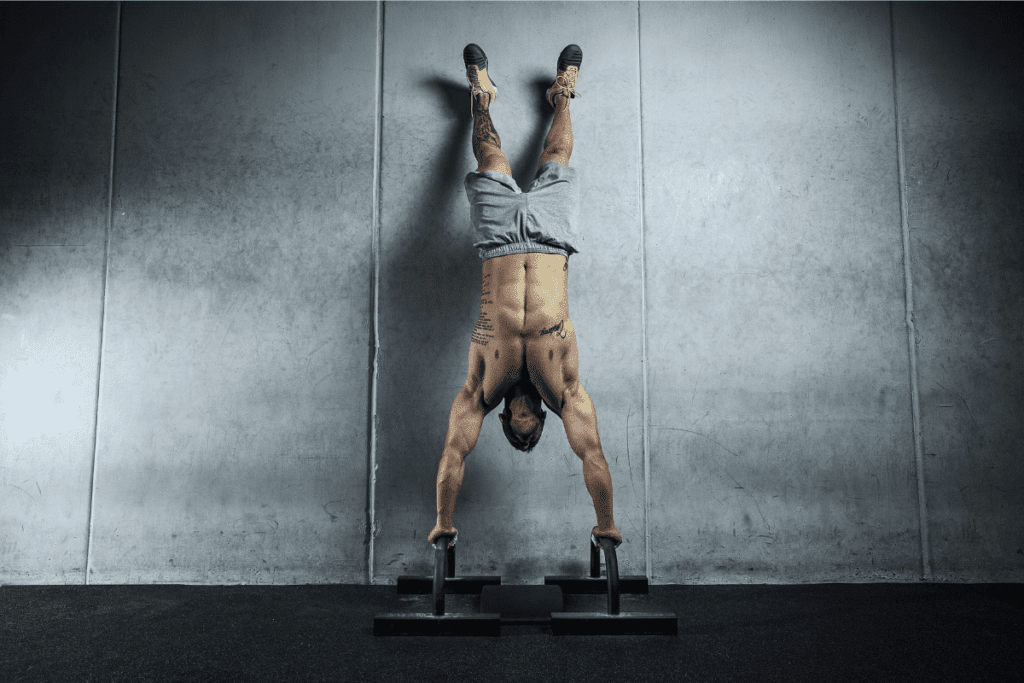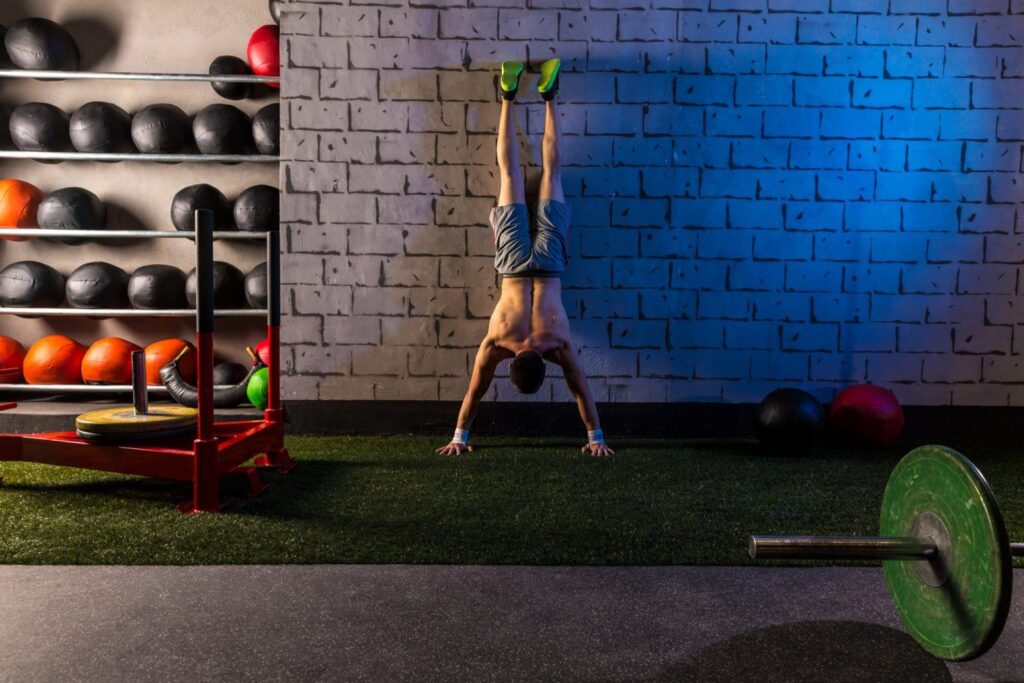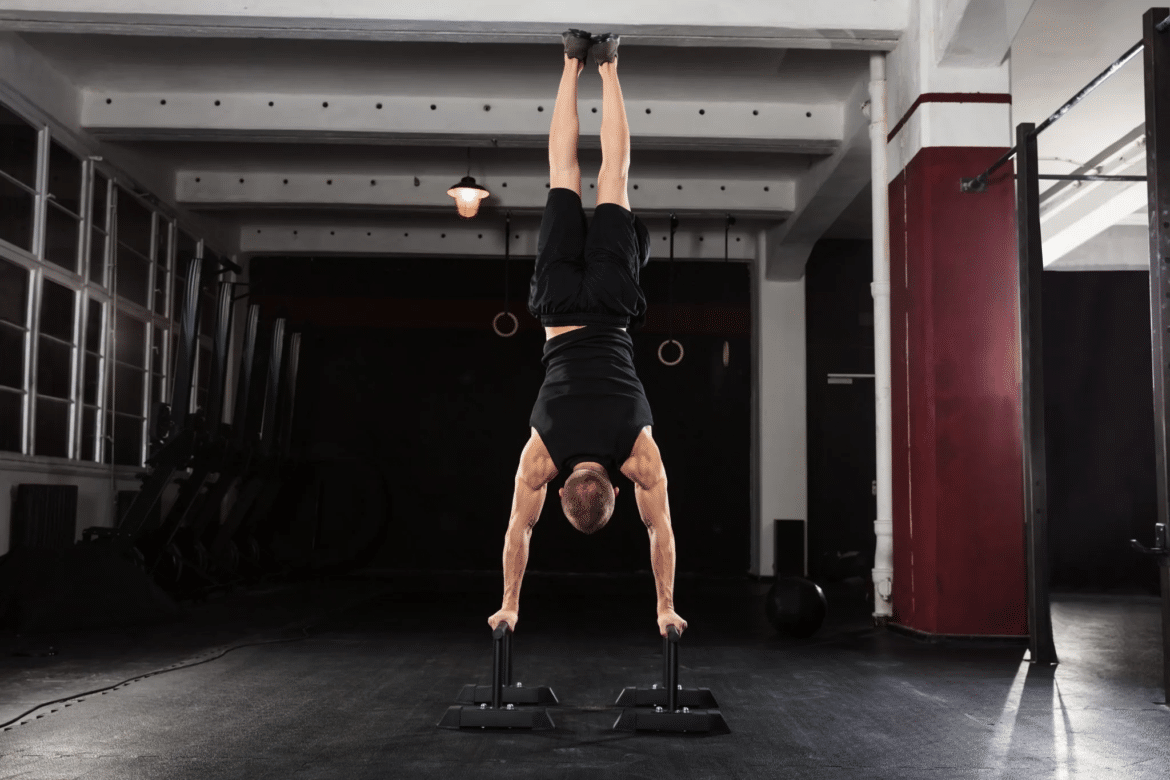Introduction
How To Do A Handstand Pushup: Mastering the art of the handstand pushup is not just a display of impressive strength and balance; it’s a testament to the human body’s incredible potential for adaptation and skill development. Whether you’re a seasoned fitness enthusiast or just embarking on your fitness journey, the handstand pushup is a challenging and rewarding exercise that can take your upper body strength to new heights. We will walk you through the step-by-step process of performing a handstand pushup, providing you with the knowledge and techniques needed to safely and effectively execute this remarkable feat of strength.
At first glance, the handstand pushup might seem like an intimidating, gravity-defying feat, but it’s essential to remember that like any other exercise, it can be broken down into manageable steps and progressions. We’ll start by focusing on the fundamentals, which include building the necessary shoulder and core strength, as well as refining your handstand position and balance. As you gradually gain confidence and strength, we’ll guide you through the proper form and technique to safely execute a full range of motion handstand pushup. This exercise not only targets your shoulders, but also engages your triceps, chest, and core, making it an excellent addition to your upper body workout routine.
Mastering the handstand pushup may seem daunting, but with dedication, patience, and consistent practice, you can achieve this impressive fitness milestone. So, whether you’re aiming to impress your friends, compete in calisthenics, or simply challenge yourself to new heights, this guide will equip you with the knowledge and skills to confidently and safely perform a handstand pushup.

How hard is it to do a handstand pushup?
Both handstand push-ups and one-arm handstands are advanced bodyweight exercises that require a high level of strength, balance, and control. The difficulty of each exercise can vary depending on an individual’s strength, skill level, and experience with bodyweight training.
Strength and Conditioning: Handstand pushups require significant upper body strength, particularly in the shoulders, triceps, and chest. If you already have a strong upper body and core, you may find handstand pushups easier to start with. If not, you may need to spend more time developing your strength.
Balance and Coordination: Maintaining balance while in a handstand position is crucial for performing handstand pushups. This aspect can be challenging for individuals who haven’t practiced handstands before.
Skill and Technique: Proper technique is essential to perform a handstand pushup safely and effectively. Learning the correct form and practicing the movement pattern can be challenging, especially for beginners.
Flexibility: Adequate shoulder and wrist flexibility is necessary for a comfortable handstand position. Limited flexibility can make handstand pushups more challenging and increase the risk of injury.
Fear and Mental Barrier: The fear of falling over can be a significant psychological barrier to overcome. This fear can make handstand pushups feel more challenging, especially in the early stages of training.
Are handstand push-ups effective?
Performing handstand pushups improves strength in the shoulders, lats, traps, pecs, and triceps. Although handstand push ups don’t involve much of the lower body, it is a multi-jointed exercise that recruits many muscles at once.
Strength Building: Handstand push-ups primarily target the shoulders, triceps, and upper chest muscles. Performing them requires a significant amount of upper body strength. This exercise can help you develop and tone these muscle groups, contributing to improved overall upper body strength.
Core Stabilization: Maintaining a stable handstand position necessitates strong core muscles. Handstand push-ups engage the core muscles to keep your body aligned, which is essential for balance and control. As a result, it’s an effective exercise for building core strength.
Balancing Skills: Handstand push-ups involve balancing your body upside down. This element of balance and coordination challenges your proprioception and spatial awareness, enhancing your overall body control and agility.
Functional Fitness: Handstand push-ups are considered a functional exercise because they mimic real-life movements. They can improve your ability to push or press objects overhead, making them useful for everyday activities and sports that involve similar motions.
Progressive Overload: You can easily adjust the intensity of handstand push-ups by changing the angle of your body, making it suitable for individuals at different fitness levels. You can start with wall-assisted handstand push-ups and gradually progress to freestanding handstand push-ups as your strength and skill improve.
Variation and Challenge: For those looking to add variety to their workouts, handstand push-ups can be an exciting and challenging addition. They provide an opportunity to break away from traditional weightlifting routines and incorporate bodyweight exercises into your regimen.
Mental Focus: Handstand push-ups require focus, concentration, and overcoming the fear of being upside down. Practicing these exercises can enhance mental toughness and build confidence in your physical capabilities.
Why are handstands so hard?
Why are handstands so hard? Handstands are one of the most difficult bodyweight exercises because they require full-body strength and balance. You need a strong core, lower and upper body, in order to hold the weight for a long while being in a downwards facing position.
Balance and Coordination: Achieving and maintaining balance while upside down is one of the primary challenges of a handstand. It requires precise coordination of your muscles and body position, and it can take time to develop the necessary balance.
Strength Requirements: Handstands place a significant load on the shoulders, arms, and upper body muscles. To hold yourself upright, you need strong shoulders, triceps, and core muscles. If you lack the required strength, maintaining a handstand can be extremely challenging.
Wrist Flexibility: Handstands place stress on the wrists, and having sufficient wrist flexibility is crucial for comfort and injury prevention. Many beginners experience discomfort or strain in their wrists when learning handstands.
Fear of Falling: Fear of falling over is a common psychological barrier when attempting handstands. Overcoming this fear and gaining the confidence to balance on your hands is a process that takes time and practice.
Technique and Form: Proper technique is essential for handstands. Small errors in form can make it challenging to maintain balance and can lead to inefficient use of your strength. Learning and mastering the correct technique is a crucial part of the process.
Progression: Handstands are often perceived as advanced exercises, and attempting them without prior experience or proper progression can be difficult. Starting with easier progressions, like wall-supported handstand or pike push-ups, can make the journey to a full handstand more manageable.
Core Strength: A strong core is vital for maintaining a straight body position in a handstand. If your core muscles are weak, it can be challenging to keep your legs and lower back aligned.
Consistency and Practice: Handstands require regular practice to develop the necessary strength, balance, and confidence. Consistency is key, and it can take weeks or even months to progress from basic handstand preparations to full freestanding handstands.
How long will it take to do handstand pushups?
It depends on your current body condition. This is for experienced person who can do and hold a handstand correctly for long time. If you’re already able to do handstand for a long time, you can learn this with practice in two to three weeks.
Starting Point: Your current fitness level and familiarity with related exercises like handstands and regular pushups will influence how quickly you progress. If you’re already strong and have experience with handstands, it might take less time.
Consistent Practice: Consistency is key. Regular practice, ideally several times a week, will help you make progress more quickly. Aim for short but focused practice sessions rather than occasional, longer attempts.
Progressive Overload: Start with easier progressions, such as wall-supported handstand or pike push-ups, and gradually work your way up to full handstand pushups. As you become more comfortable with these earlier progressions, you can move on to more advanced variations.
Core and Shoulder Strength: Building the necessary strength in your shoulders and core is crucial. Focus on strengthening these muscle groups through targeted exercises and workouts that emphasize these areas.
Balance and Technique: Learning proper technique and balance is a critical aspect of handstand pushups. This may take some time to develop, and it’s essential to prioritize safe and correct form over speed of progress.
Individual Factors: Everyone’s body is different. Some individuals may progress faster due to their natural aptitude for balance and strength, while others may take longer. Be patient with your own unique journey.
Fear and Confidence: Overcoming the fear of being upside down and falling is often a significant psychological barrier. Gaining confidence and trusting your abilities may take time.
Do handstand pushups build chest?
Since a handstand push-up is a compound movement of a handstand and a push-up that both target the upper body, performing this can obviously strengthen your chest, shoulders, and triceps.
Stabilization: During a handstand pushup, especially when you’re in the bottom position with your body inverted, your chest muscles help stabilize your body and maintain proper form. They assist in keeping your upper body aligned and preventing excessive flaring of the elbows.
Isometric Contraction: While handstand push ups focus on the shoulders and triceps for the primary pressing motion, your chest muscles engage isometrically to provide stability and support during the exercise. This means your chest muscles contract to maintain your body position without undergoing a full range of motion.
If your goal is to specifically target and build your chest muscles, there are more effective exercises, such as bench presses, push-ups, and various chest fly variations, which isolate the chest to a greater extent. These exercises involve a full range of motion and provide a more direct chest workout. However, incorporating handstand pushups into your routine can still be beneficial for overall upper body strength and balance, and they can complement a well-rounded chest training program.
What muscles do you need for a handstand pushup?
The deltoids in the shoulder musculature, the pectoral muscles (pectoralis major and pectoralis minor) and the main back muscles (back extensor, trapezius, latissimus dorsi and some smaller muscles) do the bulk of the work.
Shoulders (Deltoids): The deltoid muscles are the primary movers in a handstand pushup. They are responsible for the pressing motion as you push your body up from the inverted position.
Triceps: The triceps, located on the back of your upper arms, play a significant role in extending your elbows as you push your body up during the exercise.
Upper Chest (Pectoralis Major): While the chest muscles aren’t the primary movers, they help stabilize your body during the handstand pushup, especially in the bottom position.
Upper Back (Trapezius and Rhomboids): These muscles are responsible for scapular stabilization, keeping your shoulder blades in the correct position to perform the exercise safely and efficiently.
Core Muscles (Abdominals and Obliques): Your core muscles engage to maintain a straight body position while in the handstand. This is crucial for balance and preventing arcing or bending at the waist.
Forearms and Wrist Flexors: These muscles are essential for maintaining a strong grip and wrist stability, which is particularly important during the handstand phase.
Legs (Hamstrings and Glutes): Your legs help control your body position during the handstand and handstand pushup. They should be kept straight and engaged to prevent any unnecessary movements.
Balance and Stabilizing Muscles: Various smaller muscles throughout your body are involved in maintaining balance, control, and stability while inverted.
How much weight is a handstand push up?
To perform a handstand pushup requires pressing your bodyweight (minus the weight of your arms). Furthermore, the range of motion is slightly less, unless you use Paralletes to achieve a deeper HSPU. Therefore, you only need 80% of BW to get the full HSPU.
The amount of weight lifted during a handstand push-up (HSPU) depends on your body weight and the force required to perform the exercise. In a handstand push-up, you are lifting a significant portion of your own body weight, and this weight varies from person to person. To estimate the weight lifted, you can use your body weight, but keep in mind that this calculation is a simplified representation.
For example, if you weigh 150 pounds (68 kilograms), during a handstand push-up, you are essentially lifting approximately 75 pounds (34 kilograms) of your body weight. This calculation is based on the assumption that your legs and lower body are contributing to the support, and your upper body (from the hips up) is being lifted.
That the actual force required can vary due to factors like the angle of your body, your technique, and the distribution of your weight. Additionally, the effort required during a handstand push-up may feel different for different individuals based on their strength and fitness level.
Can handstand pushups replace pushups?
Unless you are “fit” by definition, don’t even try them. Handstand pushups focuses on you shoulders rather than chest, abs, and arms which a normal pushups can. There are more than 25 types of pushups you can try and they are more fun to do rather than boring standard pushups.
Muscle Emphasis: Handstand pushups primarily target the shoulders and triceps, with significant engagement of the upper back and core. Pushups, on the other hand, emphasize the chest, triceps, and anterior deltoids, with involvement of the core and upper back to a lesser extent.
Range of Motion: Push Ups involve a greater range of motion in the chest and shoulders. During a handstand pushup, the range of motion is limited by the position of your body and arms, which can be shorter than that of a standard pushup.
Skill and Balance: Handstand pushups require balance and skill, as you are in an inverted position. This makes them a more advanced exercise compared to pushups, which are accessible to individuals at various fitness levels.
Progression: Handstand pushups can be more challenging for beginners, whereas pushups offer a more gradual progression. It’s often recommended to start with regular pushups and progress to handstand pushups if you have the necessary strength and balance.

Conclusion
The handstand pushup is not only a remarkable demonstration of strength and balance but also a testament to the dedication and discipline required in fitness training. This advanced bodyweight exercise demands a solid foundation of strength in the shoulders, core, and upper body, which can be developed through consistent training and progressive overload. It is important to start with the basics, focusing on building up your handstand and push up skills separately before attempting the full handstand pushup. As you progress, remember that safety is paramount, and always have a spotter or use a sturdy support surface to reduce the risk of injury.
Mastering the handstand pushup is not just a physical endeavor but a mental one as well. Developing the mental fortitude to overcome the fear of falling and the perseverance to push through the challenging learning curve is just as crucial as building physical strength. Setting clear goals, tracking your progress, and maintaining patience can help you stay motivated on this demanding journey.
Handstand pushup is a testament to the remarkable capabilities of the human body when subjected to consistent training and unwavering determination. As you work on perfecting this challenging exercise, remember that the process itself is a rewarding adventure filled with self-discovery and personal growth, ultimately leading to improved strength, balance, and confidence in your fitness journey. So, embrace the challenge, stay persistent, and enjoy the exhilarating journey of mastering the handstand pushup.


2 comments
Hello there, just became alert to your blog through
Google, and found that it is truly informative. I’m going to watch out
for brussels. I’ll appreciate if you continue this in future.
Lots of people will be benefited from your writing.
Cheers! Escape room
I have read so many articles on the topic of the blogger lovers however
this piece of writing is really a fastidious paragraph,
keep it up.